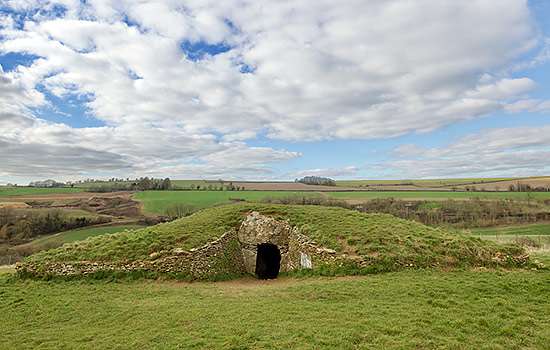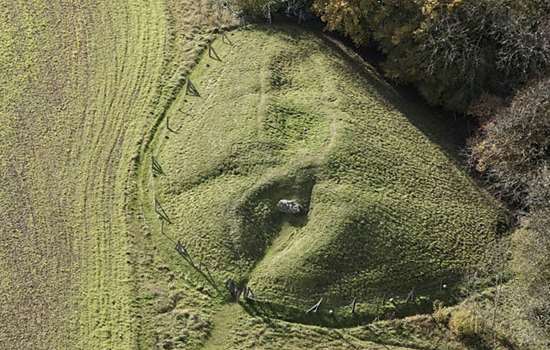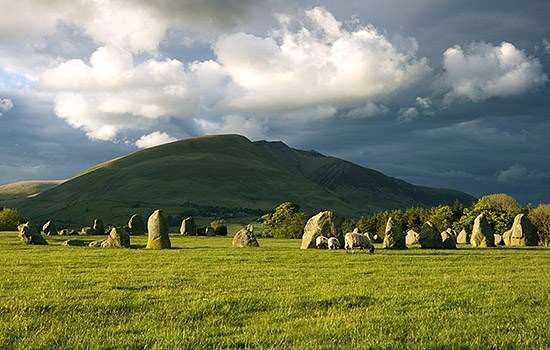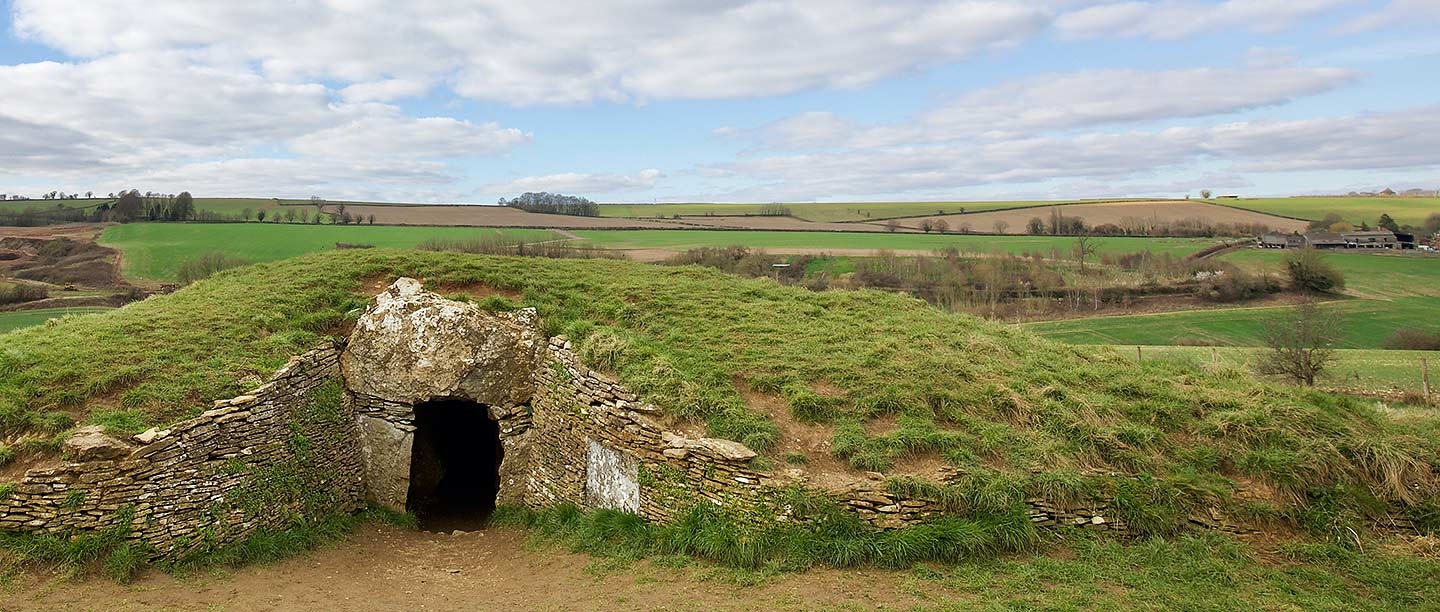Long barrows
A ‘barrow’ is a prehistoric mound of earth and stone, built as a tomb, and intended to be a prominent monument in the landscape. The tradition of burying and commemorating the dead in this way developed in western Europe in the 5th millennium BC and was brought to Britain in the early Neolithic period, from about 3800 BC onwards.
About 200 barrows in southern Britain are of a type known as the Cotswold–Severn long barrows. They are long earthen mounds, often trapezoidal in shape and slightly thinner at one end. The common features of these long barrows are an external entrance space or ‘forecourt’ at the wider end and a stone-built passage or passages leading to burial chambers.
Modern excavation of long barrows (other than Stoney Littleton) has shown that many people – men, women and children – were buried inside. The human remains found include both whole burials and cremated remains. Radiocarbon dating evidence and DNA research show that these barrows were only used for three or four generations, with older human remains being carefully moved at regular intervals to make space for the newly deceased. At nearby Hazleton North long barrow in Gloucestershire, 35 members of the same extended Neolithic family were buried in the tomb.
The trapezoidal shape of these barrows has been compared to Neolithic axes, and to the form of the human torso. Perhaps the dead were understood to be re-entering the womb of the earth after their death. The mounds were undoubtedly important to Neolithic farming communities, both as shrines to visit and as monuments that marked their local landscape.
Find out more about long barrowsDescription
The Stoney Littleton chambered long barrow is about 30 metres (100 feet) long and 12.5 metres (40 feet) wide at the broader entrance end. The mound is 2 metres (6 feet) high but was once even taller. A low dry-stone wall retains the earthen mound, and at the broader end a pair of substantial flanking walls defines a forecourt and leads to a small entrance. This leads into a narrow passage, some 13 metres (42 feet) long.
The passage is built so that visitors – both Neolithic and modern – have to bow their heads to walk into and down the passage. The 1.8 metres (6 feet) of headroom reduces in height to just 1.2 metres (4 feet) at the far end. The passage leads to three pairs of small burial chambers, with a seventh chamber at the far end.
The layout of the passage and chambers at Stoney Littleton is more symmetrical and complicated than in most other long barrows.
Excavation and investigation
In about 1760 a local farmer opened the top of the barrow from above to quarry some stone. Half a century later, in 1816, the local rector, John Skinner, and the early archaeologist Sir Richard Colt Hoare excavated the interior of the barrow. They later reported: ‘We met with many fragments of bones, etc, which had probably been removed from the sepulchral recesses [the chambers off the passage].’ As well as the skeletal remains, they found cremated human bone and a pot. Although their excavation was not up to modern archaeological standards, they published their discoveries in the journal Archaeologia, including detailed plans and sections. They also kept some of the human remains they had discovered, some of which are now in the Bristol Museum and Art Gallery.
In 1857–8 the Somerset Archaeological and Natural History Society carried out repair and conservation work at the barrow, rebuilding its retaining wall.
As part of English Heritage’s programme of conservation work, Cotswold Archaeology carried out further excavation here in 1995, 1999, 2012 and 2014. They investigated the retaining wall, and showed that the buried lower parts of the wall are probably the original Neolithic structure, with the upper parts largely rebuilt in the 1850s. They also recovered human bone and Neolithic flint tools, as well some Roman pottery left in the late 3rd or 4th century AD.
Although no radiocarbon dates have been obtained from Stoney Littleton, a programme of scientific dating of five other Cotswold–Severn long barrows showed that they were built between about 3750 and 3400 BC and were used for about three or four generations.
The ammonite fossil
On the stone slab that forms the left jamb of the entrance into the passage there is a prominent ammonite fossil. This is a sea creature of the extinct genus Arietites, related to the modern octopus but with a large spiral shell. Fossils like these were formed about 200 million years ago, when shallow seas covered much of what is now southern Britain. Ammonite fossils are the result of a process known as permineralisation, which occurs when dissolved mineral deposits fill the cavities of a decayed animal, forming a rock in the creature’s shape.
This type of ammonite fossil is referred to in English folklore as a ‘snakestone’, a serpent that has been turned to stone. The tradition is first recorded in Somerset in the 18th century but there are earlier descriptions of such stones, including by the Roman naturalist Pliny the Elder in the 1st century AD. He described them as the curling ram’s horns of the Egyptian god Ammon (hence the name ‘ammonite’).
Prehistoric people collected fossils, and they may have interpreted these strange stones as some sort of magical transformation, or as symbols created by ancestors. The spiral shape of ammonites is found in other prehistoric art, including on tombs. The stones were probably perceived to have magic powers of healing or protection.
The prominent display of the fossil at the entrance to the Stoney Littleton barrow must surely be a visual statement by the builders of the tomb, perhaps intended to protect or identify the burials inside.
The commemorative plaque
As part of the restoration of 1857–8, a stone tablet was placed in the right (eastern) forecourt wall of the barrow. The inscription read:
This tumulus, declared by competent judges to be the most perfect specimen of Celtic antiquity still existing in Great Britain, having been much injured by the lapse of time, or the carelessness of former proprietors, was restored in 1858 by Mr T.R. Joliffe, the lord of the hundred [of Wellow], the design of the original structure being preserved, as far as possible, with scrupulous exactness.
Much of the inscription remained legible in the early 21st century but has greatly deteriorated in recent years.
Further reading
A Bayliss et al, ‘The times of their lives: building histories for prehistory’, English Heritage Research News 6 (Spring 2007), 4–7 (accessed 30 June 2021) [the scientific dating of other long barrows]
R Colt Hoare, ‘An account of a stone barrow, in the parish of Wellow, at Stoney Littleton in the county of Somerset’, Archaeologia 19 (1821), 43–8 (subscription required; accessed 14 Sept 2021) [the original excavation report]
T Darvill, Long Barrows of the Cotswolds and Surrounding Areas (Stroud, 2004)
LV Grinsell, Stoney Littleton Long Barrow (HMSO guidebook, London, 1978)
C Hilts, ‘Family matters: tracing kinship links in a Neolithic tomb’, Current Archaeology 384 (March 2022), 14–15 (accessed 7 Feb 2022)
Historic England research record for Stoney Littleton (accessed 30 June 2021)
Historic England scheduled monument listing for Stoney Littleton (accessed 30 June 2021)
WW Skeat, ‘“Snakestones” and stone thunderbolts as subjects for systematic investigation’, Folklore 23.1 (1912), 45–80 (subscription required; accessed 14 Sept 2021) [discussion of the folklore of ‘snakestones’]
Related content
-

Visit Stoney Littleton Long Barrow
Stoney Littleton is one of the country's finest accessible examples of a Neolithic chambered tomb, with multiple burial chambers open to view.
-

Long Barrows and Broken Bones
What the atmospheric long barrows of the Cotswold Hills and Marlborough Downs reveal about burial practices and attitudes to death in the early Neolithic period.
-

PREHISTORIC MONUMENTS
England’s prehistoric monuments span almost four millennia. Discover what they were used for, how and when they were built, and where to find them.
-

MORE HISTORIES
Delve into our history pages to discover more about our sites, how they have changed over time, and who made them what they are today.
